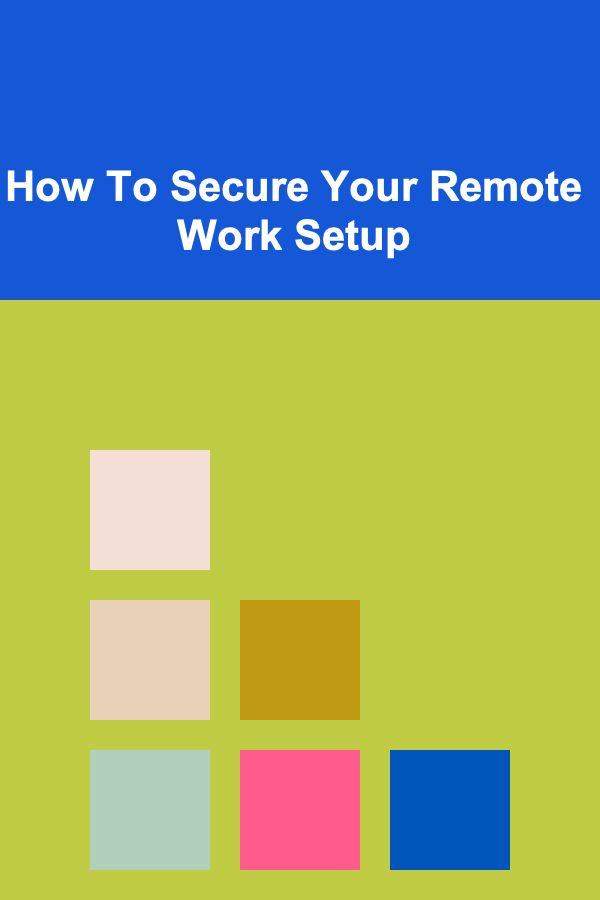
How To Secure Your Remote Work Setup
ebook include PDF & Audio bundle (Micro Guide)
$12.99$7.99
Limited Time Offer! Order within the next:

Remote work has become an integral part of the global workforce, with millions of employees working from home or other non-office environments. While this new way of working offers flexibility, autonomy, and convenience, it also brings several challenges---especially in the realm of security. The increase in remote work has led to an increase in cyber threats, which can jeopardize both personal and company data. As individuals and organizations shift toward remote work, it's crucial to understand how to secure your remote work setup to protect your privacy, data, and productivity.
This article provides a comprehensive guide on how to ensure your remote work environment is secure. It covers essential aspects such as securing devices, networks, communications, and the broader cyber hygiene practices that will keep you safe in the virtual world.
Securing Your Devices
The foundation of a secure remote work setup begins with securing the devices you use. Whether you're working from a laptop, desktop, smartphone, or tablet, these devices are often the first point of entry for cybercriminals. Let's dive into the best practices for securing these devices.
Use Strong Passwords and Multi-Factor Authentication (MFA)
One of the simplest yet most effective ways to secure your device is by using strong passwords and enabling multi-factor authentication (MFA). A strong password should be at least 12 characters long and include a combination of uppercase and lowercase letters, numbers, and special characters.
Moreover, multi-factor authentication adds an extra layer of security. Even if your password is compromised, MFA requires an additional step---such as a code sent to your phone or an authentication app---to verify your identity before granting access. This can be a game-changer in preventing unauthorized access.
Keep Software Up-to-Date
Regularly updating your operating system and applications ensures that you have the latest security patches installed. Cybercriminals often exploit vulnerabilities in outdated software, so keeping your software up to date is a fundamental aspect of device security. Enable automatic updates wherever possible to ensure you don't miss critical security patches.
Use Antivirus and Anti-Malware Software
Install and regularly update antivirus and anti-malware software to protect against malicious software and other cyber threats. These tools can detect and remove harmful programs that might attempt to compromise your device. Many antivirus solutions also provide additional features like real-time protection, firewall management, and web filtering.
Enable Device Encryption
Encrypting your devices adds a layer of protection in case they are lost or stolen. Device encryption ensures that the data on your device is scrambled and unreadable without the correct decryption key. Both Windows (BitLocker) and macOS (FileVault) offer built-in encryption options, and enabling them can greatly enhance the security of your remote work setup.
Use Virtual Private Network (VPN)
A Virtual Private Network (VPN) is essential for securing your connection when working remotely. VPNs create an encrypted tunnel between your device and the internet, making it much more difficult for hackers to intercept your data. A VPN is particularly important when using public Wi-Fi networks, which are inherently insecure.
Securing Your Network
The security of your home network is just as important as the security of your devices. A compromised network can give attackers access to all the devices connected to it. Here are the key steps to secure your home network.
Change Default Router Passwords
Most home routers come with default usernames and passwords, which are often easily accessible online. It's crucial to change these default credentials as soon as you set up your router. Use strong, unique passwords to prevent unauthorized access to your router's settings.
Use a Strong Wi-Fi Password
Make sure your Wi-Fi network is secured with WPA3 encryption, which is the latest and most secure Wi-Fi encryption standard. Additionally, use a strong, unique Wi-Fi password. Avoid using simple, guessable passwords like your pet's name or birthdate. A good Wi-Fi password should contain a mix of letters, numbers, and special characters.
Set Up a Guest Network
If you have visitors or other people who need to use your internet, it's a good idea to set up a separate guest network. This keeps your primary network secure and isolated from any potential vulnerabilities introduced by less-secure devices.
Enable a Firewall
Routers come with built-in firewalls that help protect your network from unauthorized access. Ensure that the firewall is enabled on your router and that your personal devices have their own firewalls activated as well. A firewall can monitor traffic on your network and block malicious attempts to connect to your devices.
Securing Your Communications
When working remotely, you likely communicate with coworkers, clients, and other stakeholders using a variety of digital communication tools. From emails to video conferences, securing these communication channels is essential for maintaining confidentiality and protecting sensitive data.
Use Encrypted Messaging Apps
For sensitive conversations, use encrypted messaging apps like Signal, WhatsApp, or Telegram. These apps use end-to-end encryption, which ensures that only the sender and recipient can read the messages, even if they are intercepted by a third party.
Secure Your Video Conferencing Tools
Video conferencing tools like Zoom, Microsoft Teams, and Google Meet have become the standard for remote work meetings. However, these tools can be vulnerable to cyber threats like "Zoombombing," where unauthorized individuals join and disrupt meetings. Here are some best practices to secure your video conferences:
- Use a Waiting Room: Enable a waiting room feature that lets you control who joins the meeting.
- Set a Password: Require a password to join the meeting and share it only with authorized participants.
- Limit Screen Sharing: Allow only the host or selected individuals to share their screens to prevent unwanted interruptions.
Be Wary of Phishing Scams
Phishing remains one of the most common methods cybercriminals use to gain access to personal information. Be cautious about unsolicited emails, messages, or phone calls that request sensitive information. Always verify the authenticity of any communication before clicking on links or downloading attachments.
Cyber Hygiene Best Practices
Beyond securing devices, networks, and communications, there are several everyday practices---collectively referred to as "cyber hygiene"---that can help ensure your remote work setup remains secure.
Backup Your Data
Regularly backing up your data is one of the simplest ways to mitigate the risk of data loss. Whether it's a cyberattack, a hardware failure, or accidental deletion, having a backup ensures that you don't lose important work files. Use both cloud-based storage and physical external drives for redundancy.
Use Strong, Unique Passwords for Each Account
Avoid using the same password for multiple accounts. If one account is compromised, cybercriminals could use the same credentials to access others. Use a password manager to store your passwords securely and create strong, unique passwords for every account.
Stay Educated About Security Threats
Cybersecurity is an ever-evolving field, and new threats emerge regularly. Stay informed about the latest security threats and best practices. Follow reputable sources like security blogs, industry reports, and cybersecurity organizations to stay up to date.
Limit Access to Sensitive Information
When working remotely, especially on shared or public networks, be mindful of who has access to sensitive information. Limit access to confidential data to only those who need it for their job. When possible, use "least privilege" principles, ensuring that only authorized personnel can access critical information.
Implementing Company-Wide Security Measures
If you're part of a remote team or company, there are several additional security practices to consider at the organizational level. While individual security practices are important, company-wide policies are essential for protecting the organization's sensitive data.
Use Enterprise-Level Security Tools
Organizations should invest in enterprise-level security tools that provide robust protection against cyber threats. These tools can include things like:
- Endpoint Protection: Tools that protect devices like laptops, desktops, and mobile devices from malware and viruses.
- Data Loss Prevention (DLP): Software that monitors and prevents the unauthorized transfer of sensitive information.
- Centralized Authentication: Implementing centralized login systems (such as Single Sign-On) helps manage employee access and reduces the risk of compromised accounts.
Develop a Remote Work Security Policy
Create a clear remote work security policy that outlines expectations and guidelines for employees. This policy should cover topics such as:
- Device Security: Requirements for device encryption, password strength, and software updates.
- Data Handling: Best practices for storing, sharing, and handling sensitive data remotely.
- Incident Response: A clear procedure for reporting and responding to security incidents, including data breaches or phishing attacks.
Regularly Conduct Security Training
Employee awareness is one of the most important aspects of securing remote work environments. Conduct regular security training sessions to ensure that employees understand how to recognize cyber threats, follow security best practices, and report any suspicious activities.
Conclusion
Securing your remote work setup is not a one-time task---it's an ongoing process that requires vigilance, discipline, and the right tools. By securing your devices, networks, communications, and data, you can protect yourself and your organization from the increasing risks associated with remote work. Following best practices for cyber hygiene, staying informed about the latest security threats, and fostering a culture of cybersecurity awareness will ensure that you can continue working remotely with confidence and peace of mind.
In today's interconnected world, security should be a priority for every remote worker. With the right mindset and precautions, you can safeguard your work environment and help keep sensitive data safe from cyber threats.
Reading More From Our Other Websites
- [Personal Finance Management 101] How to Save Money on Everyday Expenses Without Sacrificing Quality
- [Beachcombing Tip 101] Hidden History: Artifacts and Relics Unearthed Along the Shoreline
- [Home Party Planning 101] How to Create a Themed Home Party Experience: From Concept to Execution
- [Home Security 101] Best Home Security Systems: Integrated with Smart Home Technologies
- [Personal Care Tips 101] How to Treat Dandruff with the Best Haircare Routine for Scalp Health
- [Beachcombing Tip 101] Budget-Friendly Beachcombing Tools That Deliver Professional Results
- [Personal Financial Planning 101] How to Minimize Debt While Building Your Credit History
- [Home Space Saving 101] How to Save Space in Your Pantry with Smart Organization Hacks
- [Home Space Saving 101] How to Use Hidden Compartments to Save Space in Your Home
- [Horseback Riding Tip 101] How to Build a Portable Riding Arena for Pop‑Up Events

How to Create a Dedicated Space for Craft or DIY Projects
Read More
How to Customize Meal Prep According to Family Preferences
Read More
How to Keep Track of Your Sewing Projects and Goals
Read More
How to Sell Personalized Pet Portraits on Etsy: A Comprehensive Guide
Read More
How to Use Magnetic Strips for Storing Small Items
Read More
10 Tips for Weight Loss Planning with a Busy Work Schedule
Read MoreOther Products

How to Create a Dedicated Space for Craft or DIY Projects
Read More
How to Customize Meal Prep According to Family Preferences
Read More
How to Keep Track of Your Sewing Projects and Goals
Read More
How to Sell Personalized Pet Portraits on Etsy: A Comprehensive Guide
Read More
How to Use Magnetic Strips for Storing Small Items
Read More